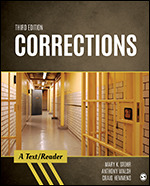Corrections: A Text/Reader
- Mary K. Stohr - Washington State University, USA
- Anthony Walsh - Boise State University, USA
- Craig Hemmens - Washington State University, USA
The Third Edition of Corrections: A Text/Reader provides students with the best of both worlds—a brief authored text accompanied by carefully selected and edited readings. Clear explanations of all of the major course topics help students understand the impact of new directions and policy in corrections. Policy-oriented original research articles demonstrate how research drives these advances. Designed throughout to enhance understanding, the book includes a helpful "How to Read a Research Article" section before the first reading, as well as article introductions, photographs, and discussion questions that capture students’ interest and help them develop their critical thinking skills.
New to the Third Edition
- Nearly 75% of the journal articles have been updated to introduce students to current research on important topics such as racial and ethnic disparities in probation, influences on inmate misconduct, transgender prison inmates, and lethal injection protocol.
- Updated and expanded coverage of ethical considerations, special populations, and the history of corrections provides students with the context for understanding policy decisions and their consequences, both past and present.
New Sections on Ethics (Section IV) and the Death Penalty (Section XVI) offer students insights into key issues in corrections today. - More coverage on disparities in sentencing and drug courts encourages students to think critically about U.S. drug policies and their effectiveness.
- Additional content on federal procedures and private prisons shows real examples of private prisons, their profit motives, and the effect they have on the correctional system.
- The most current data, facts, statistics, and research are included throughout the book to provide students with insights into the world of corrections today.
Give your students the SAGE edge!
SAGE edge offers a robust online environment featuring an impressive array of free tools and resources for review, study, and further exploration, keeping both instructors and students on the cutting edge of teaching and learning. Learn more at edge.sagepub.com/stohr3e.
Supplements
SAGE edge for Students provides a personalized approach to help students accomplish their coursework goals in an easy-to-use learning environment.
- Mobile-friendly eFlashcards strengthen understanding of key terms and concepts.
- Mobile-friendly practice quizzes allow for independent assessment by students of their mastery of course material.
- Learning objectives reinforce the most important material.
- Carefully selected chapter-by-chapter video and multimedia content which enhance classroom-based explorations of key topics
- EXCLUSIVE! Access to certain full-text SAGE journal articles have been carefully selected for each chapter. Each article supports and expands on the concepts presented in the chapter.
Password-protected Instructor Resources include the following:
- SAGE edge for Instructors, supports your teaching by making it easy to integrate quality content and create a rich learning environment for students.
- A Microsoft® Word® test bank is available containing multiple choice, true/false, short answer, and essay questions for each chapter. The test bank provides you with a diverse range of pre-written options as well as the opportunity for editing any question and/or inserting your own personalized questions to effectively assess students’ progress and understanding.
- Editable, chapter-specific PowerPoint® slides offer complete flexibility for easily creating a multimedia presentation for your course.
- Lecture notes summarize key concepts by chapter to help you prepare for lectures and class discussions.
- Lively and stimulating ideas for class activities that can be used in class to reinforce active learning. The activities apply to individual or group project.
- EXCLUSIVE! Access to full-text SAGE journal articles that have been carefully selected to support and expand on the concepts presented in each chapter is included.
- Video and web resources provide further research and insights that bring concepts to life and make learning easier.
- Access to all tables, figures, learning objectives, and chapter outlines from the text.
Sample Materials & Chapters
Section 1: The Philosophical and Ideological Underpinnings of Corrections
Section 2: Correctional History


